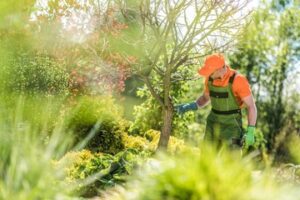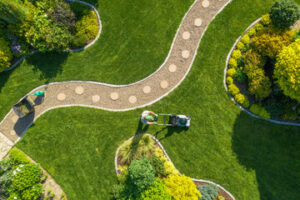Keeping an eye on trees prevents damage and ensures they grow properly. It’s much easier to address problems like invasive plants, pests and diseases before they cause damage than it is to deal with them after the fact.

Minimize foot and vehicle traffic near young trees to reduce root compaction. Avoid tying or wrapping items around the trunk, which can strangle or girdle the tree and prevent uptake of water and nutrients. Visit their Website for more details.
Pruning is the practice of selectively removing specific parts of a plant, including branches, stems, and roots. It can be used for a variety of reasons and is an important part of regular tree care, helping to promote health and aesthetics. Pruning also reduces safety risks and the need for costly cleanups, and can help prevent damage to property or structures from overhanging limbs and branches.
Pruning removes dead or weakened branches to reduce risk of failure, and can improve the appearance of a landscape by removing overgrown or unsightly limbs. This can help reduce glare and improve visibility, while also promoting airflow and light penetration for lower branches and adjacent plants. In fruit trees, it can help increase yield by allowing more light to reach the canopy to stimulate flower and fruit production.
It helps reduce the spread of disease and pests by removing spore-producing buds from the surface of the trunk and limbs. This is particularly important for trees that are in decline or with a diseased limb because pruning cuts can disrupt spore formation, slowing the rate of decline and potentially preventing future outbreaks. Pruning also removes abrasive or invasive bark from the trunk and limbs, making them less attractive to pests.
For most deciduous shrubs and shade trees, it’s best to prune them in the winter or spring before new growth begins, as this reduces the amount of sap flow from the wounds. For ornamental species such as holly, lilac, rose-of-Sharon and viburnum, pruning in the fall or summer after they’ve finished blooming is acceptable. This allows them to retain their attractive form and promotes the production of next year’s flowers. Pruning is also used to train young trees to grow in a desired form and to minimize the need for corrective pruning later on. This formative pruning should be done at the nursery or during early field establishment to promote good branch structure and a strong, healthy framework. It’s also possible to use pruning to create highly specialized shapes, such as pollarding or topiary. This is most commonly seen in professional gardens, such as hedging or sculpted ornamental species.
Soil Testing
Soil testing allows you to see how the physical and chemical characteristics of your soil affect tree health. It is a great way to identify specific soil issues, such as acidity or the presence of nutrients. A thorough analysis of your soil will help you to create a healthy, vibrant landscape that adds beauty and value to your home.
Soils are made up of a complex blend of minerals, organic material, water and air that influence how trees grow. The results of your soil test will show which nutrients are available to plants and how much fertilizer is required. This will save you money and avoid over-fertilization, which can promote excessive growth that increases the likelihood of disease. In addition, excess nutrient runoff can pollute water supplies and harm ecosystems.
Knowing which nutrients are lacking in your soil will allow you to select a fertilizer that fills the gaps. This can make a huge difference in the health of your trees, as well as the other plants on your property. It is also possible to identify soil pH levels, which can have an effect on the availability of certain nutrients.
As a general rule, most plants prefer a slightly acidic soil. Soil tests can provide a snapshot of your soil’s current acidity, which can help you to determine if the problem is caused by over- or under-applying fertilizers or by another factor.
When a soil test is done, the lab will analyze it to determine the pH level, organic matter content, nutrient content and the exchange capacity of the soil. Then, they will suggest appropriate lime and fertilizer application rates based on the results of your soil test.
Soil testing is a vital tool in the maintenance of a lush, verdant urban canopy. It helps you to address any issues early on before they have an impact on the overall health and appearance of your trees. To learn more about how to conduct soil testing and what the results will indicate, contact our team of certified arborists today. We are dedicated to helping Nashville property owners maintain a thriving landscape that contributes to the city’s natural beauty and economy.
Pests & Diseases
Trees are an integral part of the environment, providing shade, clean air and wildlife habitat. However, they are also susceptible to pests and disease that can damage or kill them. Preventative care, such as proper pruning and soil management, can help trees to resist many pests.
Regular visual inspections can help homeowners detect early signs of disease or insect infestation in their trees. Signs vary from tree to tree and may include wilting, unusual leaf discoloration or holes in the leaves or bark. Early detection can help ensure that a problem is treated before it gets out of control.
A common example of an invasive insect pest that has impacted the health of urban and suburban forests is the emerald ash borer (EAB). This metallic green beetle targets and kills ash trees by burrowing under the bark where it creates galleries that halt the flow of nutrients, causing the tree to starve to death.
Other examples of diseases that can affect the health and appearance of a landscape include oak wilt, verticillium wilt, thousand cankers, leaf spots and hawthorne leaf blight. Some of these diseases can be cured with fungicide treatments, but others cannot be completely eliminated (such as oak wilt).
The first step in managing pests and disease is to identify the cause or symptoms of the problem. Our PHC Specialists perform a detailed examination of each plant during a routine visit and look for any signs of a disease or insect infestation. They are trained to recognize beneficial insects that can be used to naturally suppress insect populations, and they also use a variety of environmentally safe, low-risk chemical treatments based on the pest life cycle and disease progression.
In addition, our PHC Specialists can provide cultural services to help minimize the impact of a pest or disease, such as physically pruning damaged branches or trunks, releasing natural predators, and installing soil-dwelling fungal organisms that can assist with deterring insect invasions. These practices can be highly effective in minimizing the need for more aggressive and toxic treatments, such as spraying with insecticides or fungicides.
ISA-Certified Arborists
A reputable arborist should be ISA-Certified, which means that they have met minimum standards set by the International Society of Arboriculture (ISA). This certification demonstrates that an individual has passed a rigorous exam in all areas of tree care. This includes, but is not limited to, tree biology, soil testing, pruning, planting, climbing and risk assessment.
Arborists are also trained to recognize many symptoms of trouble, such as leaf discoloration, wilting, cankers, abnormal growth and insect activity. By recognizing and responding to these symptoms quickly, they can often save the life of a tree.
If you are planning to plant a new tree, an arborist can help you determine the proper variety of tree for your yard and environment. They can test the soil to make sure the tree will thrive and recommend the right kind of fertilizer to keep it healthy. They can also recommend a tree that will fit your yard and home’s architecture and take into account the amount of sun or shade the area receives.
After a storm, an arborist can help restore your landscape by assessing the damage to your trees and determining what steps need to be taken to repair it. They can also prune trees to help reduce future storm damage, if necessary. A reputable arborist should only perform industry-accepted practices. For example, they should never remove an excessive amount of live wood, use spikes to climb trees that are not being removed or lop off the top of a living tree without just cause.
Investing in a qualified arborist can significantly increase the lifespan of your trees and improve your property’s value. Be sure to look for an ISA Certified Arborist before hiring any tree services, and ask to see proof of insurance. A reputable tree service will carry general liability, personal and workers’ compensation insurance to protect you from any on-the-job accidents or damages. In addition, they should be able to provide references and copies of any professional certifications, such as CPR or first aid training, chainsaw safety and a tree climbing permit.
